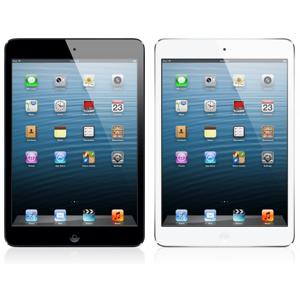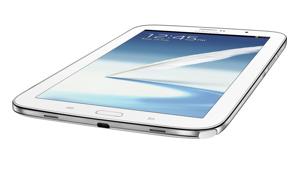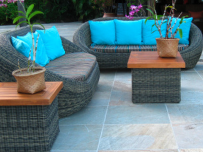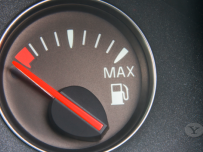'via Blog this'
Wednesday, June 05, 2013
Buying a tablet? Read this first. | Digital Crave - Yahoo!
Buying a tablet? Read this first. | Digital Crave - Yahoo!:
'via Blog this'
'via Blog this'
You don’t need a degree in electrical engineering to see the many advantages tablets have overlaptops: they’re ultrathin and very lightweight, making them easy to carry; they turn on right away and last about 10 hours on a single charge; apps are inexpensive, plentiful and simple to install and run; you can comfortably read an ebook on a tablet; and they’re drop-dead easy to use thanks to an intuitive multi-touchscreen interface.
They’re also much cheaper, on average, than a typical laptop.
Perhaps, then, it’s no surprise research firm IDC has just published a report that confirms tabletsare on track to outsell laptops in sales volume by the end of this year – and even outpace desktops by 2015.
OK, so you’re ready to buy your first or next tablet, but the big question remains: which one? Here’s a look at a few of the big players and the pros and cons for each pick.
iPad mini
Consider it a more portable and affordable version of Apple’s best-selling big brother. The Apple iPad mini (from $329) is a 7.9-inch tablet – nearly 2-inches smaller than the full-sized 9.7-inch iPad (from $499).
Pros:
iPad mini’s more compact size and lighter weight (0.6-pounds instead of 1.4 pounds) means it’s also more ideal for reading, and great for young kids with smaller hands – not to mention the simple iOS interface is the easiest to use for children and less-than-tech-savvy folks.
The tablet offers optional 4G/LTE wireless connectivity (from $459); iCloud integration to sync files between devices; AirPlay, to wirelessly play content on compatible speakers or a television via Apple TV; dual cameras; and support for magnetic Smart Covers.
Apple’s most important competitive advantage, perhaps: support for most of the 800,000+ downloads at the App Store, including 300,000 apps optimized for iPad. And then there's iTunes integration to buy or rent content including movies, TV shows, music and books.
Siri, another exclusive, lets you talk to the tablet and hear a human-like voice reply with the info you seek.
Cons:
For what you get, it’s pricey. Compare this to some other full-featured 7-inch Android tabs, which start at $199, and it makes you question why the huge price discrepancy.
Also, the screen isn’t nearly as nice as Apple’s Retina display on its full-size iPad. The text isn’t quite as crisp and colors don’t “pop” as well as they do on the third- and fourth-generation iPad’s display.
Apple’s iOS platform – which powers the iPad, iPhone and iPod touch – is also a lot more restrictive than other platforms. You can’t really customize the look of your tablet, nor can you tweak its functionality as you can with an “open” platform like Android. You also can’t multitask on the iPadlike you can on Android and Windows tabs; on iPad and iPad mini, you open one app at a time, in a linear fashion.
As the name suggests, Samsung’s latest tablet is an8-inch model, which is larger than some of the company’s offerings in the past, but more portable than its 10.1-inch tabs, too. It’s still small enough to slip into the inside of a suit jacket or medium-sized purse.
Pros:
Powered by a quad-core processor with 1.6GHz speeds, this tablet packs a lot of umph – ideal for those who like to play games, watch videos, edit photos or create music. In fact, this Android 4.2 (“Jelly Bean”) tablet can multitask very well, which also requires a fast processor and enhanced by its 2GB of system memory (RAM); whether you want to do it picture-in-picture or split-screen, perform tasks such as watching a movie while reading your email at the same time.
Along with its high-resolution WXGA display (1280 x 800 resolution), the Galaxy Note 8.0 includes an S Pen tucked into the back to write or draw on the screen – marrying a comfortable old school technology (pen and paper) with the digital age; you can also hover the S Pen over content to peek inside of folders.
Unlike the iPad and some other tablets, you can expand the memory of the Note 8.0 thanks to its microSD card slot (up to 64GB).
Other benefits of this tablet: fast Wi-Fi and Bluetooth connectivity; built-in 5.0- and 1.3-megapixel cameras; and access to the Google Play store and more than 700,000 downloadable apps. Android devices also give you more freedom to tweak the look and functionality of the tablet.
Cons:
The price. It’s $399. As far as the quality of this black or white tablet, there’s little argument it’s a premium device with quality components – but the steep cost means it’ll likely be out of reach for many.
The Note 8.0 isn’t as thin or light as the iPad mini.
Not all Android apps look or work well on all devices, as there are so many different phones and tablets that have adopted the open platform – with varying screen sizes and speeds, too – therefore don’t expect the same experience between all your Android products.
There isn’t a comprehensive digital store for all your media needs -- like iTunes -- but there are some options.
Finally, the Galaxy Note 8.0 doesn’t offer a cellular option like there is for the iPad and iPad mini.
Amazon’s popular Kindle Fire HD is a 7-inch Android-powered tablet that sells for $199 – or $20 less if you buy before Father’s Day (they had a similar promotion for Mother’s Day).
Pros:
For the price, the Kindle Fire HD offers a lot of bang for the buck. It features a high-definition (1280 x 800) multi-touch glare-free screen, fast Wi-Fi speeds – up to 35 percent faster than iPad mini, says Amazon – and battery life that lasts up to 11 hours between charges.
It’s a Kindle, so it’s a great ebook reader with access to millions of books. Plus, Amazon Prime subscribers ($79/year) have access to the Kindle Lending Library, which has more than 270,000 books to borrow for free with no due dates -- including over 100 current and former New York Times best sellers. This is one of the more unique features of the tablet.
On a related note, the Prime service delivers nearly 25 million on-demand movies, TV shows, songs, magazines, audiobooks, and popular apps and games – handled via the tablet’s 1.2 GHz dual-core processor and stereo speakers with Dolby audio.
While there’s no rear camera like the one found on the iPad mini and some other tablets, the 0.87-pound Kindle Fire HD does sport a front-facing HD camera for taking “selfies” or making video calls using Skype.
Cons:
Unfortunately, this device doesn't give you access to the Google Play store, which has hundreds of thousands of apps -- though there are a bunch you can download through Amazon's curated collection such as Gmail or Microsoft Exchange, and social media apps like Facebook, Twitter and YouTube. There’s still a few thousand, but for the same price you can get a Google Nexus 7, which gives you full reign at the Google Play store.
Web browsing is also slower on the Kindle Fire HD than many other Android-based tablets.
Unlike Kobo, Nook and Sony Reader, you can’t borrow books for free from your local library as Kindles do not support the .ePub format.
Manufactured by Asus but branded by Google, the Nexus 7 (from $199 for 16GB) is a relatively affordable Android tablet that has a lot going for it.
Pros:
The Google Nexus 7 is a thin and light 7-inch tablet – measuring 0.4-inches thick and weighing just 0.7 pounds – but houses a quad-core processor and runs on the latest Android 4.2 “Jelly Bean” platform.
The scratch-resistant high-definition screen (1,280 x 800 resolution) is easy on the eyes thanks to bright colors and good contrast (resulting in deep, dark blacks). The screen can also be viewed at wide angles (up to 178 degrees), which makes it easy for two side-by-side kids to watch something at the same time, for example. Battery life is very good at more than 10 hours between charges, overall, or about 8 hours of uninterrupted HD video playback.
Because it’s an Android device it benefits greatly from the Google Play store, now with more than 700,000 apps to customize the tablet in a myriad of ways. Plus, there are many integrated Google apps — such as Search, Maps, Gmail, Google+, YouTube, Chrome browser, etc. — and smooth multitasking for those who like to juggle multiple apps at once.
Speaking of content, a few freebies are preloaded on the Google Nexus 7: the feature filmTransformers: Dark Side of the Moon, along with Robert Ludlum’s The Bourne Dominion ebook and some free music, too.
Users can also opt for a Wi-Fi + cellular model, for $299 (32GB).
Updated 06.04.13, 2:20pm: I removed the reference to the microSD card slot.
Cons:
While you’ve got more options on how to customize it, they’re simply not as easy to use compared to the iPad – which is the case for all Android tablets.
- This tablet only has one (forward-facing) camera instead of two, and it's not a great one.
- There is no HDMI port to connect the tablet to a big-screen TV, monitor or projector.
- Compared to iOS, the Android app experience, overall, isn’t as good as Apple’s iPad.
Microsoft Surface Pro
The Surface Pro is “a laptop in tablet form,” says Microsoft, which is also reflected in the $899.99 price tag for the 64GB version (or $100 more for 128GB of storage).
Pros:
Created from durable magnesium, the 2-poundSurface Pro – Microsoft’s second computer, behind the underpowered Surface RT ($499.99 for 32GB) – houses an Intel Core i5 processor and fast graphics processor to handle apps designed for work and play. With the former, only Windows 8 tabs have familiar PC programs like Microsoft Word, Excel, PowerPoint, Outlook and OneNote, as well as desktop apps like Adobe Photoshop and Quicken.
Instead of small and static icons, Windows 8 tablets like this one has large “live tiles” on its Start screen that shows you information at a glance, without even needing to tap it.
A bundled pen lets you jot down notes, annotate PDFs or sketch out drawings in Evernote like a digital napkin with your next million-dollar idea.
Unlike most other tablets, Surface Pro also lets you connect accessories to the tablet with its full-size USB port, microSDXC card slot (to add up to 64GB of extra storage) and Bluetooth 4.0 for wireless mice, keyboards and headsets.
When you’re ready to have some fun, you can prop out the integrated kickstand and watch movies on its 10.6-inch HD screen. A mini DisplayPort lets you connect the tablet to a big-screen TV, monitor or projector, if desired.
Speaking of entertainment, the Xbox Music Pass services gives you unlimited access to millions of songs – including the option to download music to listen to offline.
Cons:
Aside from the relatively steep price – more than 3 times as much as the Google Nexus 7 – Microsoft doesn’t even throw in the Type Cover, sold separately for $129.99 (seriously). The Type Cover gives you a classic laptop keyboard built into a thin cover that magnetically affixes to the front of the screen to protect it when not in use.
Windows 8 apps are pale in comparison to iOS and Android – in selection, navigation and price. Microsoft has a lot of work to do in this regard, having come from behind compared to its competition.
There aren’t nearly as many accessories designed for Surface Pro, compared to the many thousands of Apple and Samsung cases, stands, bags and other add-ons that help add some longevity and customizability to your purchase.
Yahoo! readers, what tablet do you own, and why? Or which one are you saving for?
1 - 6 of 18
Subscribe to:
Post Comments (Atom)



















































































No comments:
Post a Comment